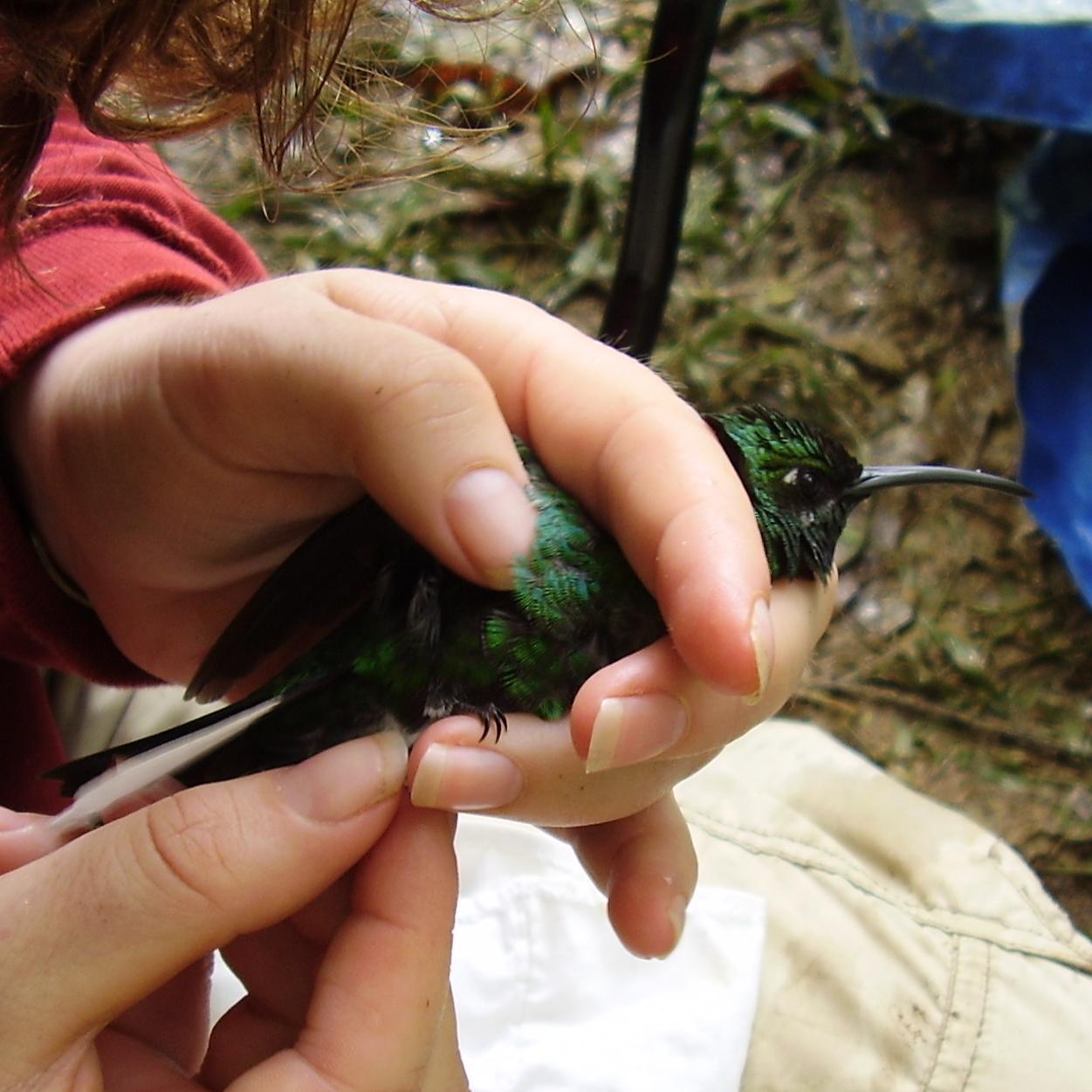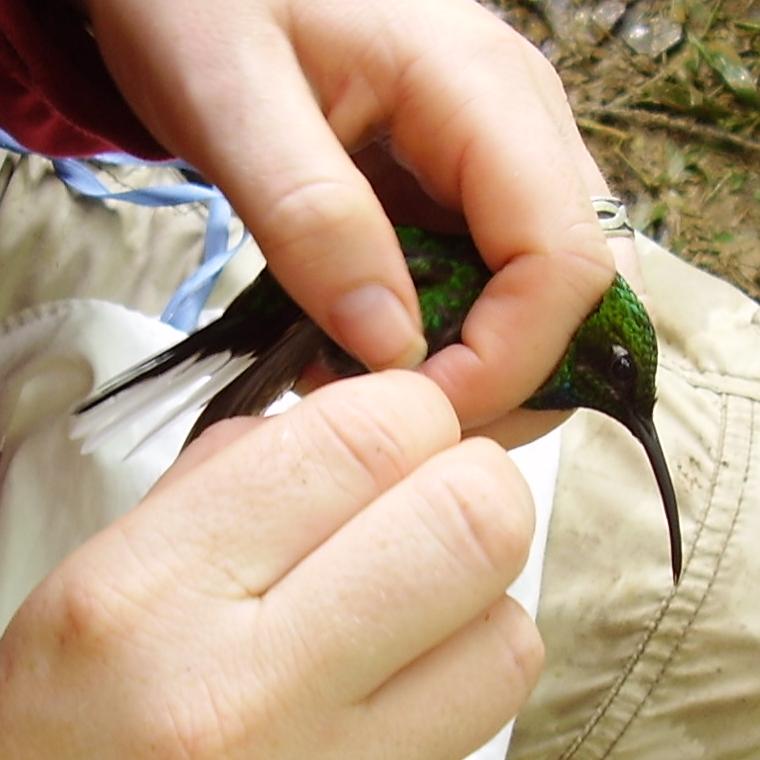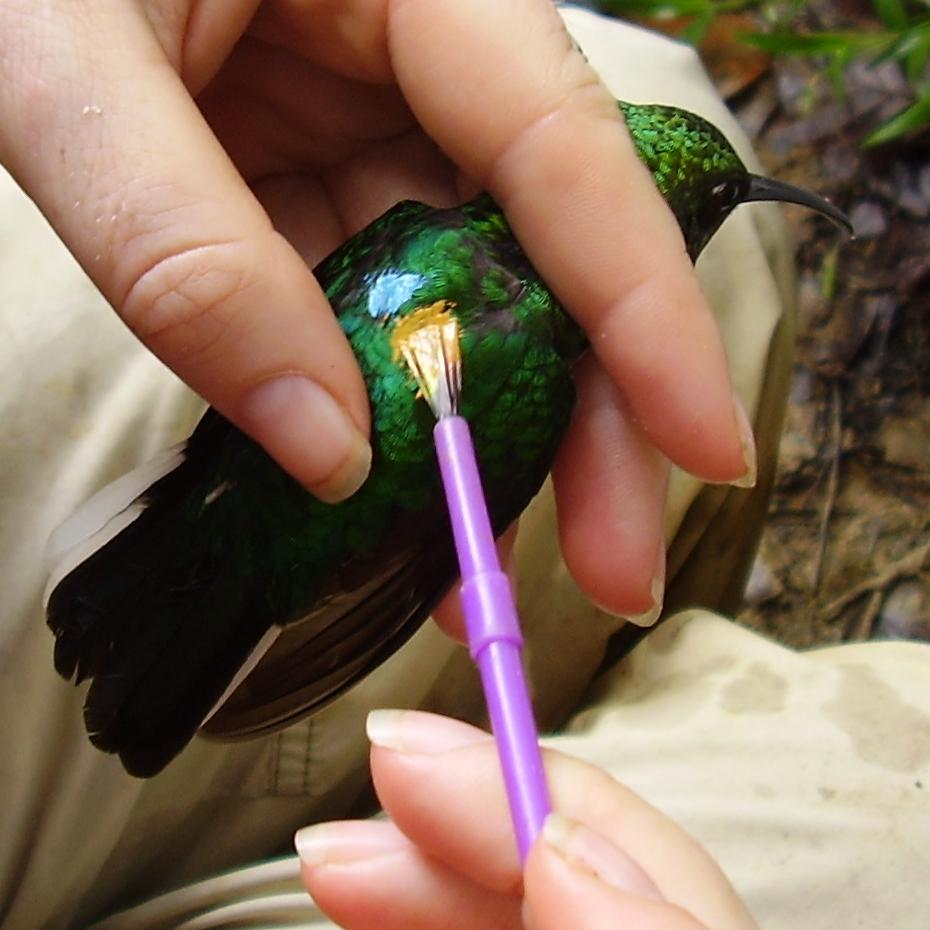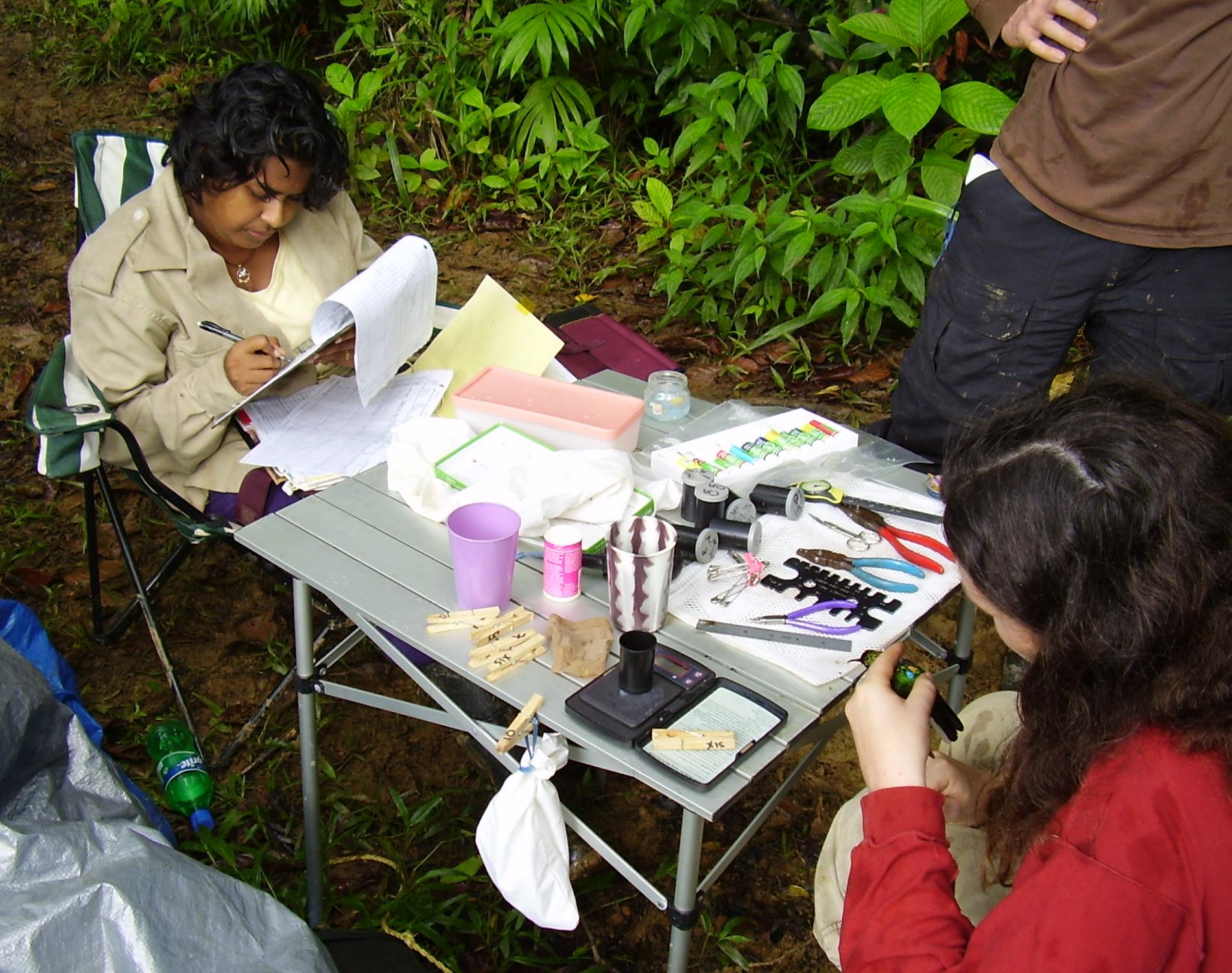The white-tailed Sabrewing (Campylopterus ensipennis) is considered to be globally
threatened (Collar et al., 1992). It is found in the Cordillera de Caripe and Paria Peninsula,
both in northeast Venezuela, and in Tobago, West Indies. The Tobago population was thought to
be extinct after
hurricane Flora hit the Island in 1963 when almost all the island's forest was destroyed. The
species was then rediscovered in 1974 (ffrench, 1991). The Venezuela population is also under
threat by widespread deforestation. The EMA has funded a project on the sabrewing in Tobago
from January 2005; additional support has been received from the Tobago House of Assembly and
UWI, St. Augustine.
 The white-tailed Sabrewing is the largest hummingbird in Tobago. It is 12cm long and weighs
approximately 10g, with a slightly decurved black bill. ffrench (1991) gives a description of
the habitat and status, range, measurements, voice, food, nesting and behaviour of the Tobago
population. According to ffrench the Tobago population was previously a common resident in
hill-forested areas, the montane forest of the Main Ridge Forest Reserve. ffrench believed
that his rediscovery of the species in 1974 indicated a gradual re-establishing of the
population. Dr Floyd Hayes (formerly of Caribbean Union College, Port of Spain, and UWI, St.
Augustine) initiated a study "Project Sabrewing" in 1995. Sabrewings were found
at elevations above 280 m in mature montane forest, and in open areas such as the edges of
clearings, in patches of forest in abandoned plantations, and in regenerating forest less
than 15 m tall, suggesting plasticity in ecological requirements. In Venezuela the species is
a locally common resident in coffee plantations, forest borders, and light woodland; they are
much less numerous inside montane forest.
The white-tailed Sabrewing is the largest hummingbird in Tobago. It is 12cm long and weighs
approximately 10g, with a slightly decurved black bill. ffrench (1991) gives a description of
the habitat and status, range, measurements, voice, food, nesting and behaviour of the Tobago
population. According to ffrench the Tobago population was previously a common resident in
hill-forested areas, the montane forest of the Main Ridge Forest Reserve. ffrench believed
that his rediscovery of the species in 1974 indicated a gradual re-establishing of the
population. Dr Floyd Hayes (formerly of Caribbean Union College, Port of Spain, and UWI, St.
Augustine) initiated a study "Project Sabrewing" in 1995. Sabrewings were found
at elevations above 280 m in mature montane forest, and in open areas such as the edges of
clearings, in patches of forest in abandoned plantations, and in regenerating forest less
than 15 m tall, suggesting plasticity in ecological requirements. In Venezuela the species is
a locally common resident in coffee plantations, forest borders, and light woodland; they are
much less numerous inside montane forest.
 Hayes' group attempted to determine the distribution and population size of the white-tailed
sabrewing using trail surveys, and banded 81 birds caught in mist nets.
They described the current status of the sabrewing as being widely scattered from Mt. Dillon
in the west to Hermitage Hill in the east, but absent (maybe rare) in parts of their former
range including Hillsborough Reservoir in the Southwest and Pigeon Peak in the east,
suggesting that the population was still in the process of expanding to these areas.
Information on the distribution (former range) of the Sabrewing before 1963 is lacking. The
current study uses mist netting, trail surveys and behavioural observations to continue study
of this vulnerable species, which was declared one of the first three Environmentally
Sensitive Species by the EMA in 2005 (the other two being the piping guan or pawi, and the
manatee). Behavioural observations concentrate on reproduction, which is thought to involve a
lek (Hayes et al., 1997).
Hayes' group attempted to determine the distribution and population size of the white-tailed
sabrewing using trail surveys, and banded 81 birds caught in mist nets.
They described the current status of the sabrewing as being widely scattered from Mt. Dillon
in the west to Hermitage Hill in the east, but absent (maybe rare) in parts of their former
range including Hillsborough Reservoir in the Southwest and Pigeon Peak in the east,
suggesting that the population was still in the process of expanding to these areas.
Information on the distribution (former range) of the Sabrewing before 1963 is lacking. The
current study uses mist netting, trail surveys and behavioural observations to continue study
of this vulnerable species, which was declared one of the first three Environmentally
Sensitive Species by the EMA in 2005 (the other two being the piping guan or pawi, and the
manatee). Behavioural observations concentrate on reproduction, which is thought to involve a
lek (Hayes et al., 1997).
 Daveka Boodram studied the sabrewing between January 2005 and December 2006,
with volunteer assistants
recruited internationally through the internet
(www.osnabirds.org/on/ornjobs.htm).
In 2005 Tricia Rodriguez (USA) helped from January to March, Jennifer Corlett (Canada) from April
to June, and Maren Gimpel
and Daniel Small (USA) from October to December. One bird banded by
Project Sabrewing (in 1999) was recaptured in 2005, out of a total of 129 sabrewings captured
in 2005 and 2006. Individuals were colour marked to help
study the behaviour and
breeding requirements of the sabrewing, especially the lekking
system.
A poster on preliminary results was
given at the 15th Annual Conference of the Society for the Conservation and Studies of
Caribbean Birds (SCSCB) in Guadeloupe, July 30th-August 6th 2005.
Daveka Boodram studied the sabrewing between January 2005 and December 2006,
with volunteer assistants
recruited internationally through the internet
(www.osnabirds.org/on/ornjobs.htm).
In 2005 Tricia Rodriguez (USA) helped from January to March, Jennifer Corlett (Canada) from April
to June, and Maren Gimpel
and Daniel Small (USA) from October to December. One bird banded by
Project Sabrewing (in 1999) was recaptured in 2005, out of a total of 129 sabrewings captured
in 2005 and 2006. Individuals were colour marked to help
study the behaviour and
breeding requirements of the sabrewing, especially the lekking
system.
A poster on preliminary results was
given at the 15th Annual Conference of the Society for the Conservation and Studies of
Caribbean Birds (SCSCB) in Guadeloupe, July 30th-August 6th 2005.
Funding
- TT$ 97,500 (two years), Environmental Management Authority (EMA) of Trinidad and Tobago.
- TT$ 4,200 (2005), to attend 15th Annual Conference of the Society for the Conservation and Study of
Caribbean Birds, Guadeloupe, July 2005. Travel grant, Campus Research and Publication Fund, The
University of the West Indies, St. Augustine.
Supervision
- Supervisor: Dr Adrian Hailey, Department of Life Sciences, University of the West
Indies, St. Augustine.
- Advisor: Prof. Floyd E. Hayes, Department of Biology, Pacific Union College, Angwin,
CA 94508, USA. (Sabrewing ecology)
- Advisor: Prof. Joseph M. Wunderle, Jr, International Institute of Tropical Forestry, U.S.D.A.
Forest Service, Puerto Rico 00773, USA. (Tropical ornithology)
Results
-
Boodram, D.S. (2012). Developing a Management Plan for the White-tailed Sabrewing (Campylopterus
ensipennis) in the Main Ridge
Forest Reserve, Tobago, West Indies. Thesis,
Department of Life Sciences, The University of the West Indies, St. Augustine, x+195 pp.
M.Phil. in Zoology awarded 2013.
-
Boodram, D. (2011). Management and Recovery Plan for the White-tailed Sabrewing
(Campylopterus ensipennis). Final report to the Environmental Management Authority, 82 pp.
Department of Life Sciences, The University of the West Indies, St. Augustine.
-
Boodram, D. (2011). Management and Recovery Plan for the White-tailed Sabrewing
(Campylopterus ensipennis). Appendices (on methods), 46 pp.
Department of Life Sciences, The University of the West Indies, St. Augustine.
References
Collar, N.J. et al. (1992). Threatened Birds of the Americas. The ICBP/IUCN Red Data Book,
3rd edition, part 2. Cambridge: International Council for Bird Preservation.
ffrench, R.P. (1991). A Guide to the Birds of Trinidad and Tobago. 2nd ed. Cornell University
Press, Princeton, New Jersey. 836 pp.
Hayes, F.E. (Ed.) (1995). Project Sabrewing: Status, ecology and behaviour of the
white-tailed sabrewing (Campylopterus ensipennis) on Tobago, West Indies. 1995 annual
report. 36 pp. Port of Spain: Caribbean Union College.
Hayes, F.E., Garnett, T.O., Bernard, M.V., Bullard, A.L., Hardy, D.R., Wilson, D-A. D., Wilson,
D.J., Joseph , V.L., and St. Louis, D.K. (1997). Behavioral ecology of territorial male
White-tailed Sabrewings (Campylopterus ensipennis) evidence for lek polygyny.
Pitirre 10: 27-28.
Hayes, F.E., Trimm, N.A., Sanasie, B., and ffrench, R.P. (2000). Breeding biology of the
white-tailed sabrewing at Tobago, West Indies. J. Field Ornithol. 71: 597-605.
 The white-tailed Sabrewing is the largest hummingbird in Tobago. It is 12cm long and weighs
approximately 10g, with a slightly decurved black bill. ffrench (1991) gives a description of
the habitat and status, range, measurements, voice, food, nesting and behaviour of the Tobago
population. According to ffrench the Tobago population was previously a common resident in
hill-forested areas, the montane forest of the Main Ridge Forest Reserve. ffrench believed
that his rediscovery of the species in 1974 indicated a gradual re-establishing of the
population. Dr Floyd Hayes (formerly of Caribbean Union College, Port of Spain, and UWI, St.
Augustine) initiated a study "Project Sabrewing" in 1995. Sabrewings were found
at elevations above 280 m in mature montane forest, and in open areas such as the edges of
clearings, in patches of forest in abandoned plantations, and in regenerating forest less
than 15 m tall, suggesting plasticity in ecological requirements. In Venezuela the species is
a locally common resident in coffee plantations, forest borders, and light woodland; they are
much less numerous inside montane forest.
The white-tailed Sabrewing is the largest hummingbird in Tobago. It is 12cm long and weighs
approximately 10g, with a slightly decurved black bill. ffrench (1991) gives a description of
the habitat and status, range, measurements, voice, food, nesting and behaviour of the Tobago
population. According to ffrench the Tobago population was previously a common resident in
hill-forested areas, the montane forest of the Main Ridge Forest Reserve. ffrench believed
that his rediscovery of the species in 1974 indicated a gradual re-establishing of the
population. Dr Floyd Hayes (formerly of Caribbean Union College, Port of Spain, and UWI, St.
Augustine) initiated a study "Project Sabrewing" in 1995. Sabrewings were found
at elevations above 280 m in mature montane forest, and in open areas such as the edges of
clearings, in patches of forest in abandoned plantations, and in regenerating forest less
than 15 m tall, suggesting plasticity in ecological requirements. In Venezuela the species is
a locally common resident in coffee plantations, forest borders, and light woodland; they are
much less numerous inside montane forest.
 Hayes' group attempted to determine the distribution and population size of the white-tailed
sabrewing using trail surveys, and banded 81 birds caught in mist nets.
They described the current status of the sabrewing as being widely scattered from Mt. Dillon
in the west to Hermitage Hill in the east, but absent (maybe rare) in parts of their former
range including Hillsborough Reservoir in the Southwest and Pigeon Peak in the east,
suggesting that the population was still in the process of expanding to these areas.
Information on the distribution (former range) of the Sabrewing before 1963 is lacking. The
current study uses mist netting, trail surveys and behavioural observations to continue study
of this vulnerable species, which was declared one of the first three Environmentally
Sensitive Species by the EMA in 2005 (the other two being the piping guan or pawi, and the
manatee). Behavioural observations concentrate on reproduction, which is thought to involve a
lek (Hayes et al., 1997).
Hayes' group attempted to determine the distribution and population size of the white-tailed
sabrewing using trail surveys, and banded 81 birds caught in mist nets.
They described the current status of the sabrewing as being widely scattered from Mt. Dillon
in the west to Hermitage Hill in the east, but absent (maybe rare) in parts of their former
range including Hillsborough Reservoir in the Southwest and Pigeon Peak in the east,
suggesting that the population was still in the process of expanding to these areas.
Information on the distribution (former range) of the Sabrewing before 1963 is lacking. The
current study uses mist netting, trail surveys and behavioural observations to continue study
of this vulnerable species, which was declared one of the first three Environmentally
Sensitive Species by the EMA in 2005 (the other two being the piping guan or pawi, and the
manatee). Behavioural observations concentrate on reproduction, which is thought to involve a
lek (Hayes et al., 1997).
 Daveka Boodram studied the sabrewing between January 2005 and December 2006,
with volunteer assistants
recruited internationally through the internet
(
Daveka Boodram studied the sabrewing between January 2005 and December 2006,
with volunteer assistants
recruited internationally through the internet
(